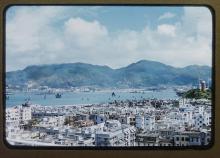Get Gwulo's books
Directory
Click on your area of interest to choose from over 30,000 pages about old Hong Kong:
- Images & photos
- View - View galleries - View new - Create - Forum topics
- View - Create - Places & buildings
- View map - View new - Create - Streets
- View map - View new - Create - People
- View - View new - Create - Organisations
- View all - View new - Create - Diaries & memoirs
- View - View new - Create diary - Create page - Events
- View - View new - Create - Jurors lists
- View - Type a page
Or choose a popular article:


Comments
p.33 - Women working on the seafront
At the bottom of page 33 I wrote that I'd never seen any women working on the seafront, using shoulder poles to unload junks. Then recently I bought this photo, and proved myself wrong!
So I'll change the bottom two paragraphs on that page from:
Back to shoulder poles – as the photo shows, in 1896 Des Voeux
Road was the centre of the shoulder pole world. Each of those masts
belonged to a junk that needed loading or unloading by men like
these. They’d pad up and down planks that ran from the harbour
wall down into the junk. There are lots of photos like this, taken
along the seafront and showing men carrying heavy loads on shoulder
poles. But only men – I haven’t seen any women among them.
We know women did exactly this kind of work, and were arguably
even stronger as they had to climb the Peak’s slopes. But as far as I
can tell the men and women kept to their own districts: women on
the hills, men on the flat land near to the seafront.
to:
Back to shoulder poles – as the photo shows, in 1896 Des Voeux
Road was the centre of the shoulder pole world. Each of those masts
belonged to a junk that needed loading or unloading by men like
these. Carrying their loaded shoulder poles, the men would pad along
the narrow planks that ran from the harbour wall down into the junk.
This seafront scene is repeated in many photos (see Volume 3, p.45
for several more examples), but looking through them I note it
is very rare to see any women. If women could haul coal up the
Peak’s slopes, they were surely strong enough to handle this kind of
work. But the photos suggest that men took most of the seafront
trade, while the carrier women worked inland and on the hillsides.
Re: Men and Women
I have seen photos of both men and women working on the waterfront and alongside boats and junks.
Re: Men and Women
Thanks Moddsey, it sounds as though I'm imagining things that don't have strong evidence to back them up. I'll rewrite the text again.
p.33 - Version two of the edit
Back to shoulder poles – as the photo shows, in 1896 Des Voeux
Road was the centre of the shoulder pole world. Each of those masts
belonged to a junk that needed loading or unloading by men like
these. Carrying their loaded shoulder poles, the men would pad along
the narrow planks that were laid between the junk and the harbour wall.
In earlier copies of this book, I wrote that I hadn’t seen any carrier
women working along the seafront, suggesting that the men
monopolised this work, while the women worked inland and on the
hillsides. In fact there wasn’t such a neat division of labour, as I’ve
since seen photos of women using shoulder poles to unload junks,
and read of men carrying loads up to the Peak.
p.33 - fixed now
The correction has been made. Books from the first reprint or later have the updated text.